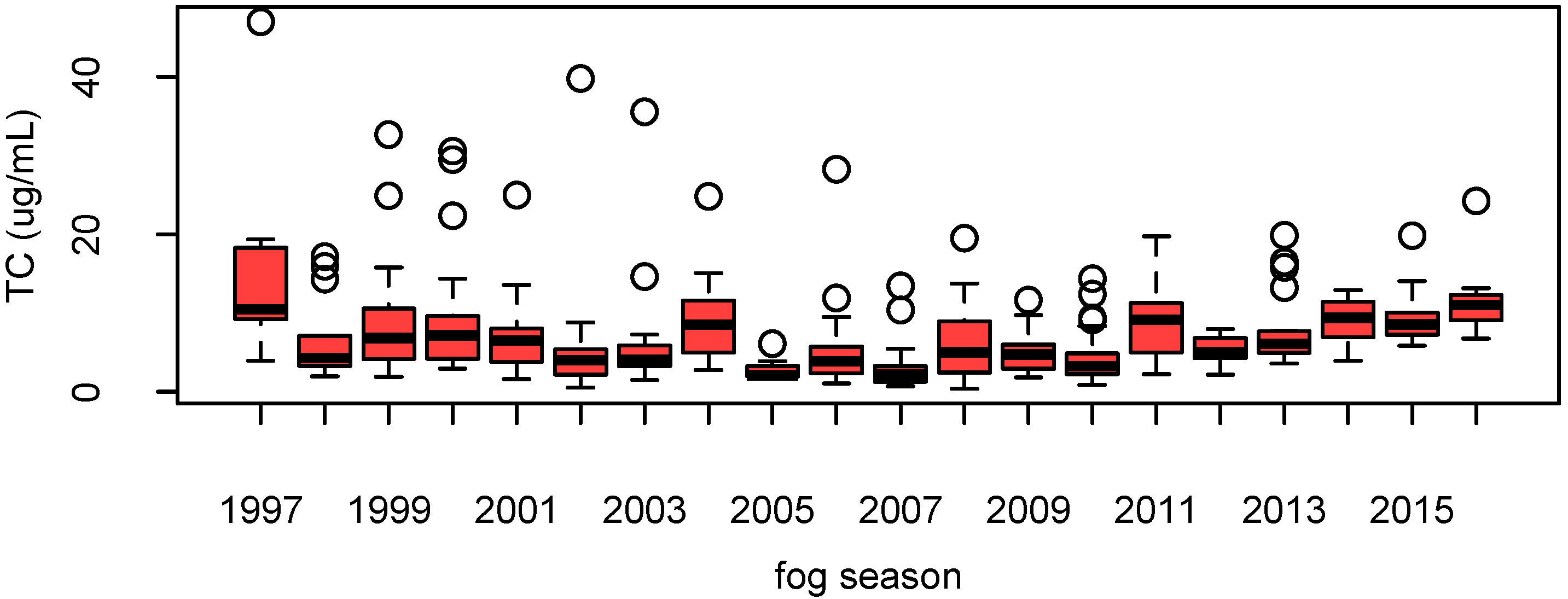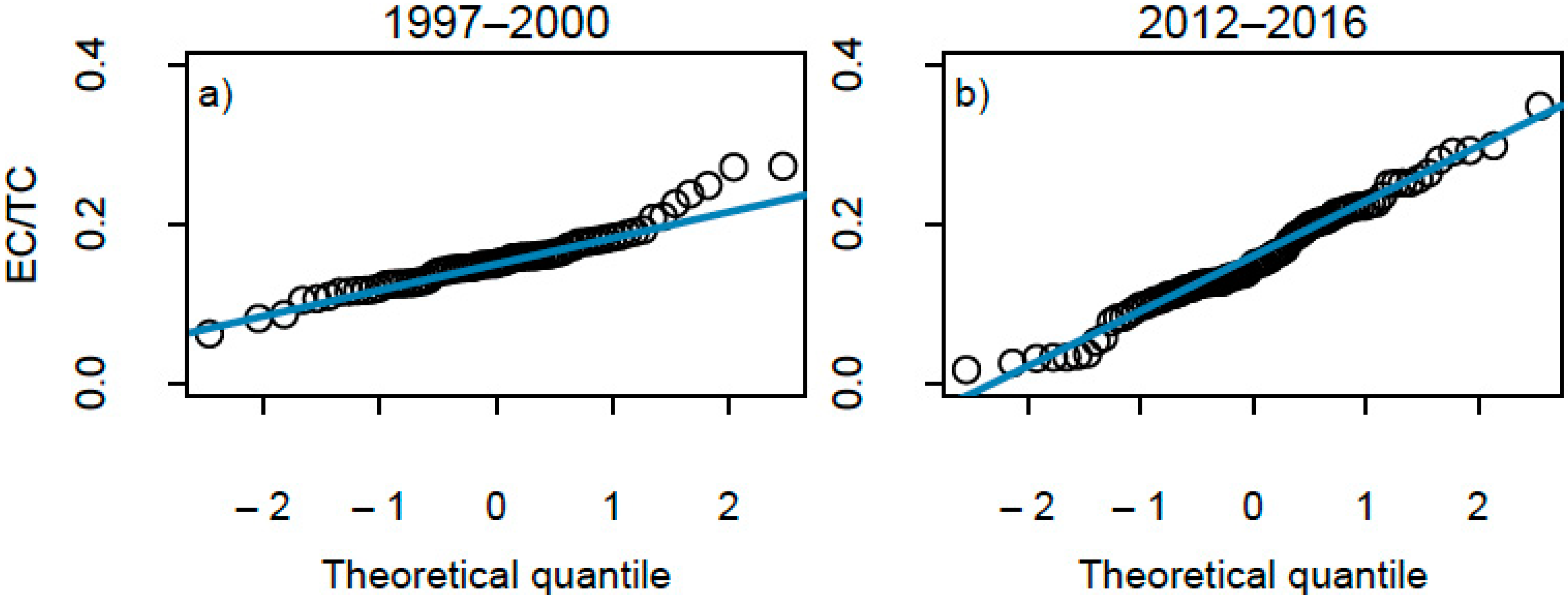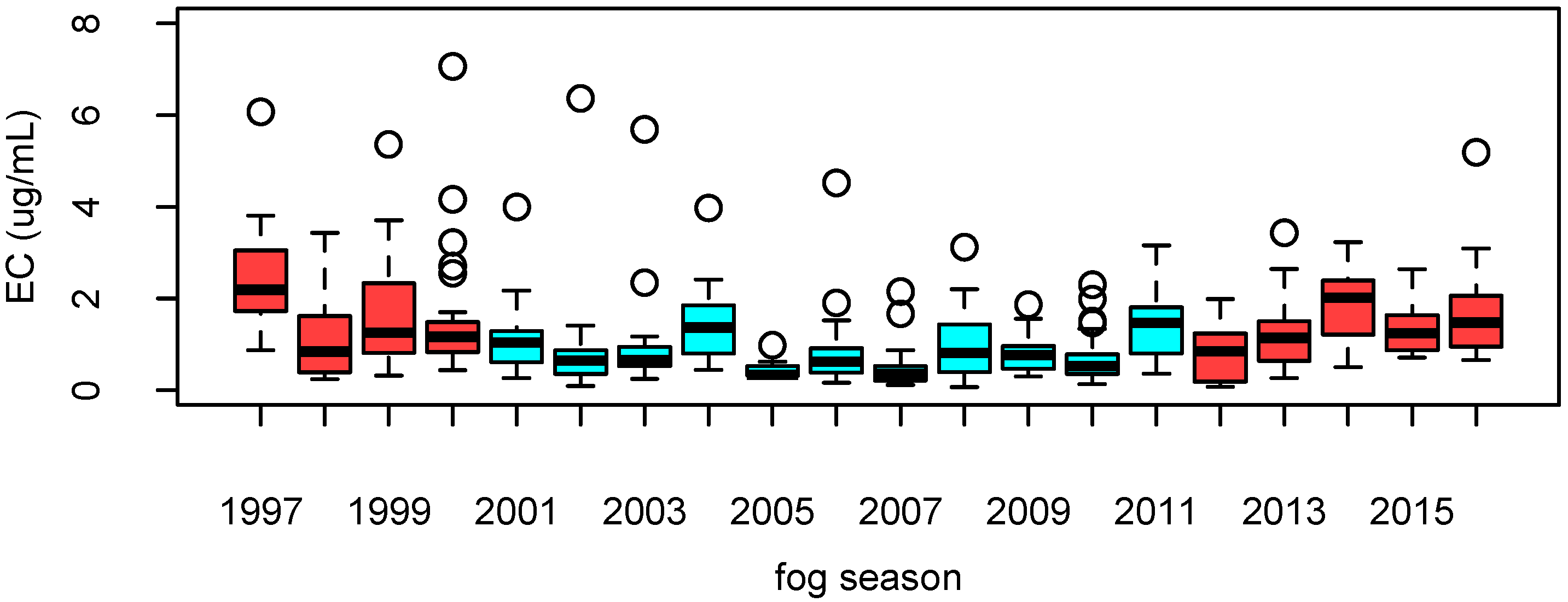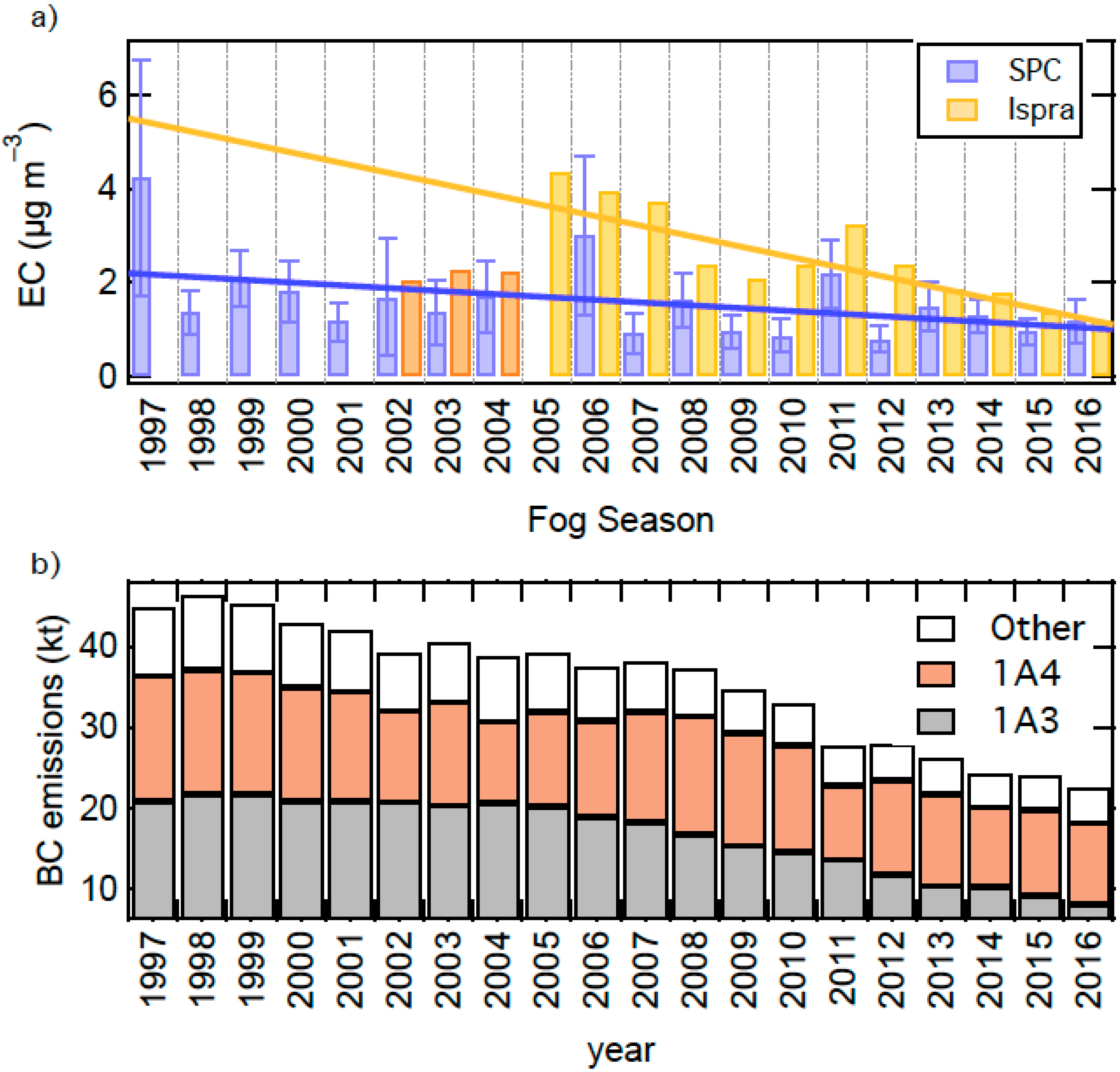Reconstructing Elemental Carbon Long-Term Trend in the Po Valley (Italy) from Fog Water Samples
Abstract
1. Introduction
2. Experiments
2.1. Sampling Sites
2.2. Fog Water Collection
2.3. Quantification of Carbonaceous Particles Suspended in Fog Water Samples
2.4. Analysis of EC in Atmospheric Aerosol Samples
3. Results and Discussion
3.1. TC and EC Seasonal Trends
3.2. Atmospheric EC Concentrations
3.3. Long-Term Trends of Atmospheric EC Concentrations
4. Conclusions
Author Contributions
Funding
Acknowledgments
Conflicts of Interest
References
- Bond, T.; Doherty, S.; Fahey, D.; Forster, P.; Berntsen, T.; DeAngelo, B.; Flanner, M.; Ghan, S.; Karcher, B.; Koch, D.; et al. Bounding the role of black carbon in the climate system: A scientific assessment. J. Geophys. Res. Atmos. 2013, 118, 5380–5552. [Google Scholar] [CrossRef]
- Janssen, N.A.H.; Hoek, G.; Simic-Lawson, M.; Fischer, P.; van Bree, L.; ten Brink, H.; Keuken, M.; Atkinson, R.W.; Anderson, H.R.; Brunekreef, B.; et al. Black Carbon as an Additional Indicator of the Adverse Health Effects of Airborne Particles Compared with PM10 and PM2.5. Environ. Health Perspect. 2011, 119, 1691–1699. [Google Scholar] [CrossRef] [PubMed]
- IPCC. Special Report on Global Warming of 1.5 °C; IPCC: Geneva, Switzerland, 2018. [Google Scholar]
- Hand, J.; Schichtel, B.; Malm, W.; Frank, N. Spatial and Temporal Trends in PM2.5 Organic and Elemental Carbon across the United States. Adv. Meteorol. 2013, 2013, 367674. [Google Scholar] [CrossRef]
- Torseth, K.; Aas, W.; Breivik, K.; Fjaeraa, A.; Fiebig, M.; Hjellbrekke, A.; Myhre, C.; Solberg, S.; Yttri, K. Introduction to the European Monitoring and Evaluation Programme (EMEP) and observed atmospheric composition change during 1972–2009. Atmos. Chem. Phys. 2012, 12, 5447–5481. [Google Scholar] [CrossRef]
- Husain, L.; Khan, A.; Ahmed, T.; Swami, K.; Bari, A.; Webber, J.; Li, J. Trends in atmospheric elemental carbon concentrations from 1835 to 2005. J. Geophys. Res. Atmos. 2008, 113, D13102. [Google Scholar] [CrossRef]
- Legrand, M.; Preunkert, S.; Schock, M.; Cerqueira, M.; Kasper-Giebl, A.; Afonso, J.; Pio, C.; Gelencser, A.; Dombrowski-Etchevers, I. Major 20th century changes of carbonaceous aerosol components (EC, WinOC, DOC, HULIS, carboxylic acids, and cellulose) derived from Alpine ice cores. J. Geophy. Res. Atmos. 2007, 112, D23S11. [Google Scholar] [CrossRef]
- Fagerli, H.; Legrand, M.; Preunkert, S.; Vestreng, V.; Simpson, D.; Cerqueira, M. Modeling historical long-term trends of sulfate, ammonium, and elemental carbon over Europe: A comparison with ice core records in the Alps. J.Geophy. Res. Atmos. 2007, 112, D23S13. [Google Scholar] [CrossRef]
- EEA. Status of Black Carbon Monitoring in Ambient Air in Europe; European Environmental Agency: Copenhagen, Denmark, 2013. [Google Scholar]
- EEA. Air Quality in Europe—2014 Report; European Environmental Agency: Copenhagen, Denmark, 2014. [Google Scholar]
- Fuzzi, S.; Facchini, M.; Orsi, G.; Lind, J.; Wobrock, W.; Kessel, M.; Maser, R.; Jaeschke, W.; Enderle, K.; Arends, B.; et al. The Po Valley fog experiment 1989—An overview. Tellus Ser. Chem. Phys. Meteorol. 1992, 44, 448–468. [Google Scholar] [CrossRef]
- Gilardoni, S.; Massoli, P.; Giulianelli, L.; Rinaldi, M.; Paglione, M.; Pollini, F.; Lanconelli, C.; Poluzzi, V.; Carbone, S.; Hillamo, R.; et al. Fog scavenging of organic and inorganic aerosol in the Po Valley. Atmos. Chem. Phys. 2014, 14, 6967–6981. [Google Scholar] [CrossRef]
- Giulianelli, L.; Gilardoni, S.; Tarozzi, L.; Rinaldi, M.; Decesari, S.; Carbone, C.; Facchini, M.C.; Fuzzi, S. Fog occurrence and chemical composition in the Po valley over the last twenty years. Atmos. Environ. 2014, 98, 394–401. [Google Scholar] [CrossRef]
- Gilardoni, S.; Vignati, E.; Cavalli, F.; Putaud, J.P.; Larsen, B.R.; Karl, M.; Stenstrom, K.; Genberg, J.; Henne, S.; Dentener, F. Better constraints on sources of carbonaceous aerosols using a combined C-14-macro tracer analysis in a European rural background site. Atmos. Chem. Phys. 2011, 11, 5685–5700. [Google Scholar] [CrossRef]
- Putaud, J.; Cavalli, F.; dos Santos, S.; Dell’Acqua, A. Long-term trends in aerosol optical characteristics in the Po Valley, Italy. Atmos. Chem. Phys. 2014, 14, 9129–9136. [Google Scholar] [CrossRef]
- Sandrini, S.; Fuzzi, S.; Piazzalunga, A.; Prati, P.; Bonasoni, P.; Cavalli, F.; Bove, M.C.; Calvello, M.; Cappelletti, D.; Colombi, C.; et al. Spatial and seasonal variability of carbonaceous aerosol across Italy. Atmos. Environ. 2014, 99, 587–598. [Google Scholar] [CrossRef]
- Fuzzi, S.; Orsi, G.; Bonforte, G.; Zardini, B.; Franchini, P.L. An automated fog water collector suitable for deposition networks: Design, operation and field tests. Water Air Soil Pollut. 1997, 93, 383–394. [Google Scholar] [CrossRef]
- Chow, J.; Watson, J.; Chen, L.; Paredes-Miranda, G.; Chang, M.; Trimble, D.; Fung, K.; Zhang, H.; Yu, J. Refining temperature measures in thermal/optical carbon analysis. Atmos. Chem. Phys. 2005, 5, 2961–2972. [Google Scholar] [CrossRef]
- Chow, J.; Watson, J.; Crow, D.; Lowenthal, D.; Merrifield, T. Comparison of IMPROVE and NIOSH carbon measurements. Aerosol Sci. Technol. 2001, 34, 23–34. [Google Scholar] [CrossRef]
- Costa, V.; Bacco, D.; Castellazzi, S.; Ricciardelli, I.; Vecchietti, R.; Zigola, C.; Pietrogrande, M. Characteristics of carbonaceous aerosols in Emilia-Romagna (Northern Italy) based on two fall/winter field campaigns. Atmos. Res. 2016, 167, 100–107. [Google Scholar] [CrossRef]
- Cavalli, F.; Viana, M.; Yttri, K.; Genberg, J.; Putaud, J. Toward a standardised thermal-optical protocol for measuring atmospheric organic and elemental carbon: The EUSAAR protocol. Atmos. Meas. Tech. 2010, 3, 79–89. [Google Scholar] [CrossRef]
- Ricciardelli, I.; Bacco, D.; Rinaldi, M.; Bonafe, G.; Scotto, F.; Trentini, A.; Bertacci, G.; Ugolini, P.; Zigola, C.; Rovere, F.; et al. A three-year investigation of daily PM2.5 main chemical components in four sites: The routine measurement program of the Supersito Project (Po Valley, Italy). Atmos. Environ. 2017, 152, 418–430. [Google Scholar] [CrossRef]
- Hallberg, A.; Ogren, J.; Noone, K.; Heintzenberg, J.; Berner, A.; Solly, I.; Kruisz, C.; Reischl, G.; Fuzzi, S.; Facchini, M.; et al. Phase partitioning for different aerosol species in fog. Tellus Ser. Chem. Phys. Meteorol. 1992, 44, 545–555. [Google Scholar] [CrossRef]
- Zhang, G.; Lin, Q.; Peng, L.; Bi, X.; Chen, D.; Li, M.; Li, L.; Brechtel, F.; Chen, J.; Yan, W.; et al. The single-particle mixing state and cloud scavenging of black carbon: A case study at a high-altitude mountain site in southern China. Atmos. Chem. Phys. 2017, 17, 14975–14985. [Google Scholar] [CrossRef]
- Yttri, K.; Simpson, D.; Bergstrom, R.; Kiss, G.; Szidat, S.; Ceburnis, D.; Eckhardt, S.; Hueglin, C.; Nojgaard, J.; Perrino, C.; et al. The EMEP Intensive Measurement Period campaign, 2008-2009: Characterizing carbonaceous aerosol at nine rural sites in Europe. Atmos. Chem. Phys. 2019, 19, 4211–4233. [Google Scholar] [CrossRef]
- Cavalli, F.; Alastuey, A.; Areskoug, H.; Ceburnis, D.; Cech, J.; Genberg, J.; Harrison, R.; Jaffrezo, J.; Kiss, G.; Laj, P.; et al. A European aerosol phenomenology-4: Harmonized concentrations of carbonaceous aerosol at 10 regional background sites across Europe. Atmos. Environ. 2016, 144, 133–145. [Google Scholar] [CrossRef]
- Zanatta, M.; Gysel, M.; Bukowiecki, N.; Müller, T.; Weingartner, E.; Areskoug, H.; Fiebig, M.; Yttri, K.E.; Mihalopoulos, N.; Kouvarakis, G.; et al. A European aerosol phenomenology-5: Climatology of black carbon optical properties at 9 regional background sites across Europe. Atmos. Environ. 2016, 145, 346–364. [Google Scholar] [CrossRef]
- Mbengue, S.; Fusek, M.; Schwarz, J.; Vodicka, P.; Smejkalova, A.; Holoubek, I. Four years of highly time resolved measurements of elemental and organic carbon at a rural background site in Central Europe. Atmos. Environ. 2018, 182, 335–346. [Google Scholar] [CrossRef]
- Klejnowski, K.; Janoszka, K.; Czaplicka, M. Characterization and Seasonal Variations of Organic and Elemental Carbon and Levoglucosan in PM10 in Krynica Zdroj, Poland. Atmosphere 2017, 8, 190. [Google Scholar] [CrossRef]
- Blaszczak, B.; Widziewicz-Rzonca, K.; Ziola, N.; Klejnowski, K.; Juda-Rezler, K. Chemical Characteristics of Fine Particulate Matter in Poland in Relation with Data from Selected Rural and Urban Background Stations in Europe. Appl. Sci. 2019, 9, 98. [Google Scholar] [CrossRef]
- Henne, S.; Brunner, D.; Folini, D.; Solberg, S.; Klausen, J.; Buchmann, B. Assessment of parameters describing representativeness of air quality in-situ measurement sites. Atmos. Chem. Phys. 2010, 10, 3561–3581. [Google Scholar] [CrossRef]
- Murphy, D.; Chow, J.; Leibensperger, E.; Malm, W.; Pitchford, M.; Schichtel, B.; Watson, J.; White, W. Decreases in elemental carbon and fine particle mass in the United States. Atmos. Chem. Phys. 2011, 11, 4679–4686. [Google Scholar] [CrossRef]
- Yamagami, M.; Ikemori, F.; Nakashima, H.; Hisatsune, K.; Osada, K. Decreasing trend of elemental carbon concentration with changes in major sources at Mega city Nagoya, Central Japan. Atmos. Environ. 2019, 199, 155–163. [Google Scholar] [CrossRef]
- Mousavi, A.; Sowlat, M.; Hasheminassab, S.; Polidori, A.; Sioutas, C. Spatio-temporal trends and source apportionment of fossil fuel and biomass burning black carbon (BC) in the Los Angeles Basin. Sci. Total Environ. 2018, 640, 1231–1240. [Google Scholar] [CrossRef] [PubMed]
- Singh, V.; Ravindra, K.; Sahu, L.; Sokhi, R. Trends of atmospheric black carbon concentration over the United Kingdom. Atmos. Environ. 2018, 178, 148–157. [Google Scholar] [CrossRef]
- ISPRA. Italian Emission Inventory 1990–2018. Informative Inventory Report 2020; ISPRA: Rome, Italy, 2020. [Google Scholar]
- D’Elia, I.; Piersanti, A.; Briganti, G.; Cappelletti, A.; Ciancarella, L.; Peschi, E. Evaluation of mitigation measures for air quality in Italy in 2020 and 2030. Atmos. Pollut. Res. 2018, 9, 977–988. [Google Scholar] [CrossRef]
- Bigi, A.; Ghermandi, G. Long-term trend and variability of atmospheric PM10 concentration in the Po Valley. Atmos. Chem. Phys. 2014, 14, 4895–4907. [Google Scholar] [CrossRef]
- Bigi, A.; Ghermandi, G. Trends and variability of atmospheric PM2.5 and PM10-2.5 concentration in the Po Valley, Italy. Atmos. Chem. Phys. 2016, 16, 15777–15788. [Google Scholar] [CrossRef]





| Site | Country | Observation Period | Size Fraction | EC (μg m−3) | Reference |
|---|---|---|---|---|---|
| Oasi le Bine (r) | Italy | 2007–2008 | PM2.5 | 0.9 | [16] |
| Genova (ur) | Italy | 2010–2011 | PM2.5 | 1.2 | [16] |
| Bari (ur) | Italy | Spring 2007 | PM2.5 | 1.7 | [16] |
| Milano (ur) | Italy | 2005–2007 | PM2.5 | 2.3 | [16] |
| Mantova (ur) | Italy | 2005–2007 | PM2.5 | 1.3 | [16] |
| Brescia (ur) | Italy | 2005–2007 | PM2.5 | 1.7 | [16] |
| Birkenes (re) | Norway | Fall 2008 Winter/Spring 2009 | PM2.5 | 0.1 0.10 | [25] |
| Ispra (re) | Italy | Fall 2008 Winter/Spring 2009 | PM2.5 | 1.5 1.5 | [25] |
| K-puszta (re) | Hungary | Fall 2008 Winter/Spring 2009 | PM2.5 | 1.2 0.77 | [25] |
| Kosetice (re) | Czech Rep. | Fall 2008 Winter/Spring 2009 | PM2.5 | 0.49 0.32 | [25] |
| Lille Valby (r) | Denmark | Fall 2008 Winter/Spring 2009 | PM2.5 | 0.46 0.37 | [25] |
| Mace Head (re) | Ireland | Fall 2008 Winter/Spring 2009 | PM2.5 | 0.12 0.11 | [25] |
| Melpitz (re) | Germany | Fall 2008 Winter/Spring 2009 | PM2.5 | 0.54 0.40 | [25] |
| Montelibretti (r) | Italy | Fall 2008 Winter/Spring 2009 | PM2.5 | 0.97 1.0 | [25] |
| Payerne (r) | Switzerland | Fall 2008 Winter/Spring 2009 | PM2.5 | 0.59 0.66 | [25] |
| Birkenes (re) | Norway | 2008–2011 | PM2.5 PM10 | 0.1 0.1 | [26] |
| Melpitz (re) | Germany | 2010–2011 | PM2.5 PM10 | 0.6 0.8 | [26] |
| Montseny (re) | Spain | 2008–2011 | PM2.5 PM10 | 0.2 0.3 | [26] |
| Ispra (re) | Italy | 2008–2011 | PM2.5 PM10 | 1.6 2.0 | [26] |
| Kosetice (re) | Czech Rep. | 2009–2011 | PM2.5 | 0.6 | [26] |
| Aspvreten (re) | Sweden | Winter seasons 2010–2011 | PM10 | 0.20 | [27] |
| Birkenes (re) | Norway | Winter seasons 2010–2011 | PM10 | 0.082 | [27] |
| Finokalia (re) | Greece | Winter seasons 2008–2010 | PM10 | 0.18 | [27] |
| Harwell (re) | United Kingdom | Winter 2010 | PM10 | 0.39 | [27] |
| Ispra (re) | Italy | Winter seasons 2008–2011 | PM2.5 | 2.03 | [27] |
| Melpitz (re) | Germany | Winter seasons 2008–2010 | PM10 | 0.55 | [27] |
| Montseny (re) | Spain | Winter seasons 2008–2011 | PM10 | 0.23 | [27] |
| Puy de Dome (re) | France | Winter seasons 2008–2010 | PM10 | 0.067 | [27] |
| Vavhill (re) | Sweden | Winter seasons 2010–2011 | PM10 | 0.30 | [27] |
| Kosetice (re) | Czech Rep. | Winter seasons 2013–2016 | PM2.5 | 0.83 | [28] |
| Krynica Zdroj | Poland | Winter 2017 | PM10 | 1.34 | [29] |
| Zloty Potok (r) | Poland | Winter 2013 | PM2.5 | 2.17 | [30] |
| Racibórz (s) | Poland | Winter seasons 2011–2012 | PM2.5 | 3.59 | [30] |
| Puszcza Boreka (re) | Poland | Winter 2011 | PM2.5 | 0.84 | [30] |
| Zielonka (r) | Poland | Winter 2011 | PM2.5 | 1.25 | [30] |
| Szczecin (r) | Poland | Winter 2013 | PM2.5 | 1.67 | [30] |
| Trzebinia (r) | Poland | Winter 2013 | PM2.5 | 3.97 | [30] |
| Prague (r) | Czech Rep. | Winter 2003 | PM2.5 | 1.69 | [30] |
| Kendall’s τ | Sen’s Slope | Mean Absolute Deviation (MAD) | |
|---|---|---|---|
| SPC | −0.43 | −0.06 μg m−3 y−1 | 0.03 μg m−3 y−1 |
| Ispra | −0.69 | −0.22 μg m−3 y−1 | 0.09 μg m−3 y−1 |
© 2020 by the authors. Licensee MDPI, Basel, Switzerland. This article is an open access article distributed under the terms and conditions of the Creative Commons Attribution (CC BY) license (http://creativecommons.org/licenses/by/4.0/).
Share and Cite
Gilardoni, S.; Tarozzi, L.; Sandrini, S.; Ielpo, P.; Contini, D.; Putaud, J.-P.; Cavalli, F.; Poluzzi, V.; Bacco, D.; Leonardi, C.; et al. Reconstructing Elemental Carbon Long-Term Trend in the Po Valley (Italy) from Fog Water Samples. Atmosphere 2020, 11, 580. https://doi.org/10.3390/atmos11060580
Gilardoni S, Tarozzi L, Sandrini S, Ielpo P, Contini D, Putaud J-P, Cavalli F, Poluzzi V, Bacco D, Leonardi C, et al. Reconstructing Elemental Carbon Long-Term Trend in the Po Valley (Italy) from Fog Water Samples. Atmosphere. 2020; 11(6):580. https://doi.org/10.3390/atmos11060580
Chicago/Turabian StyleGilardoni, Stefania, Leone Tarozzi, Silvia Sandrini, Pierina Ielpo, Daniele Contini, Jean-Philippe Putaud, Fabrizia Cavalli, Vanes Poluzzi, Dimitri Bacco, Cristina Leonardi, and et al. 2020. "Reconstructing Elemental Carbon Long-Term Trend in the Po Valley (Italy) from Fog Water Samples" Atmosphere 11, no. 6: 580. https://doi.org/10.3390/atmos11060580
APA StyleGilardoni, S., Tarozzi, L., Sandrini, S., Ielpo, P., Contini, D., Putaud, J.-P., Cavalli, F., Poluzzi, V., Bacco, D., Leonardi, C., Genga, A., Langone, L., & Fuzzi, S. (2020). Reconstructing Elemental Carbon Long-Term Trend in the Po Valley (Italy) from Fog Water Samples. Atmosphere, 11(6), 580. https://doi.org/10.3390/atmos11060580








